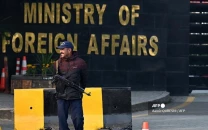Crumbling heritage: The Talpur tombs hold quiet histories long forgotten
Culture minister says it will take time to cater to all the heritage sites.

The final resting place of rulers is usually associated with large, green spaces but the Talpurs of Hyderabad are buried in tombs surrounded by a bustling, encroaching neighbourhood.
Several crumbling crypts stand together in Hirabad while another tomb stands alone in the Journalists Colony near the Hyderabad Central Jail. All of them are in utter disrepair - nobody knows much about them and nobody really cares.
“In Hyderabad, we call them ‘meeron key qubbay’ and that’s about all anyone knows of them,” says Sindh historian Mubarak Ali.
He says the custom is to build tombs in wide, open spaces and usually within a luscious green garden.
But in the case of these tombs, there were no parks and grass around.
As time went on, the heirs of the Talpur Mirs sold off the land around the tombs, till finally, today, the last resting places of Sindh’s rulers are surrounded on all sides by narrow, busy lanes, choked with houses and structures.
Ali is not impressed by the architectural beauty of these tombs, “there’s no style” he comments. However, they are part of our history and need to be preserved.
The archaeology department either knows nothing about them or just isn’t interested, he says. “If you go inside the tombs you’ll see how dirty they are.”
People in Hyderabad are accustomed to the clay-coloured domed structures but hardly anyone visits.
As for the famous Talpur Mirs, they still live in Hyderabad and are rumoured to own manuscripts and precious antiquities but they don’t like to share or show it to anyone, says the historian.
Sassui Palijo deflects
Culture minister Sassui Palijo defended the provincial government and says that most of the archaeological sites in Sindh are under the federal government. However, the department was handed over to Sindh on March 30, as part of devolution (handing over responsibility to provinces). It takes a while to make right what’s been wrong for the past 63 years, Palijo explains.
She assures that she is “very interested personally in the history of Talpurs” and has already formed a committee of five to 10 people to make a list of important heritage sites in the province. “The provincial government has signed a memorandum with Unesco and it will help us preserve our heritage,” she promises.
History of the Talpurs
Shaikh Khurshid Hasan writes that the Talpurs and the Kalhorahs were the two dynasties that ruled over Sindh before the British arrived. Mir Fateh ‘Ali Khan, the Talpur chief, defeated the last Kalhorah ruler and established his government in 1784.
He divided Sindh into three regions, Hyderabad, Khairpur and Mirpur Khas, which were each ruled by a separate branch of the family.
Hyderabad was ruled by Mir Fateh ‘Ali Khan along with his other brothers, Mir Ghulam ‘Ali Khan, Mir Karam ‘Ali and Mir Murad ‘Ali Khan. They became the ‘Chaar Yaar’ (four friends or companions) and the government was called as Chauyari.
According to talpur.org, Karam ‘Ali Khan died in 1828 and was buried in a domed mausoleum, which was constructed around 1812.
Several other family members, including their wives and children, are buried in tombs nearby. “The marble graves have the actual royal turbans of these rulers placed upon a projection at one end,” says the website.
Published in The Express Tribune, April 17th, 2011.



















COMMENTS
Comments are moderated and generally will be posted if they are on-topic and not abusive.
For more information, please see our Comments FAQ